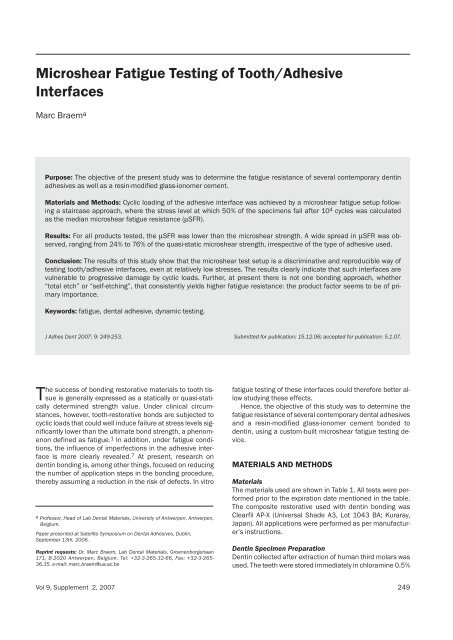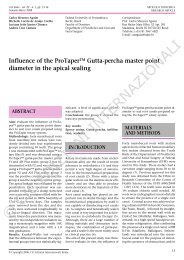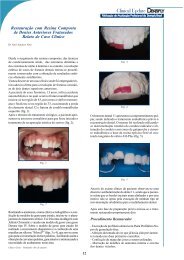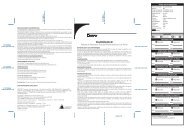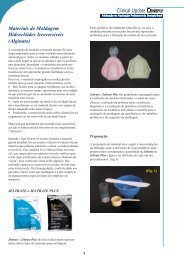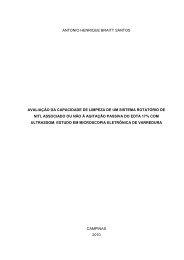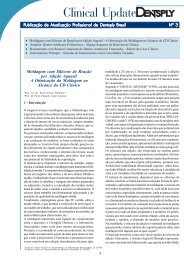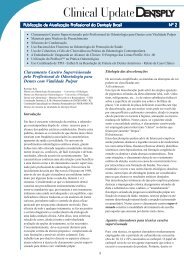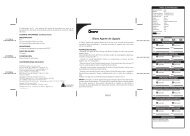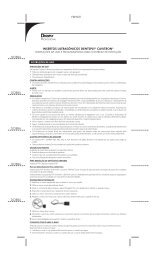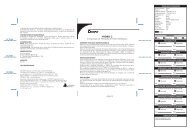You also want an ePaper? Increase the reach of your titles
YUMPU automatically turns print PDFs into web optimized ePapers that Google loves.
Microshear Fatigue Testing of Tooth/Adhesive<br />
Interfaces<br />
Marc Braem a<br />
Purpose: The objective of the present study was to determine the fatigue resistance of several contemporary dentin<br />
adhesives as well as a resin-modified glass-ionomer cement.<br />
Materials and Methods: Cyclic loading of the adhesive interface was achieved by a microshear fatigue setup following<br />
a staircase approach, where the stress level at which 50% of the specimens fail after 10 4 cycles was calculated<br />
as the median microshear fatigue resistance (μSFR).<br />
Results: For all products tested, the μSFR was lower than the microshear strength. A wide spread in μSFR was observed,<br />
ranging from 24% to 76% of the quasi-static microshear strength, irrespective of the type of adhesive used.<br />
Conclusion: The results of this study show that the microshear test setup is a discriminative and reproducible way of<br />
testing tooth/adhesive interfaces, even at relatively low stresses. The results clearly indicate that such interfaces are<br />
vulnerable to progressive damage by cyclic loads. Further, at present there is not one bonding approach, whether<br />
“total etch” or “self-etching”, that consistently yields higher fatigue resistance: the product factor seems to be of primary<br />
importance.<br />
Keywords: fatigue, dental adhesive, dynamic testing.<br />
J Adhes Dent 2007; 9: 249-253. Submitted for publication: 15.12.06; accepted for publication: 5.1.07.<br />
The success of bonding restorative materials to tooth tissue<br />
is generally expressed as a statically or quasi-statically<br />
determined strength value. Under clinical circumstances,<br />
however, tooth-restorative bonds are subjected to<br />
cyclic loads that could well induce failure at stress levels significantly<br />
lower than the ultimate bond strength, a phenomenon<br />
defined as fatigue. 1 In addition, under fatigue conditions,<br />
the influence of imperfections in the adhesive interface<br />
is more clearly revealed. 7 At present, research on<br />
dentin bonding is, among other things, focused on reducing<br />
the number of application steps in the bonding procedure,<br />
thereby assuming a reduction in the risk of defects. In vitro<br />
a Professor, Head of Lab Dental Materials, University of Antwerpen, Antwerpen,<br />
Belgium.<br />
Paper presented at Satellite Symposium on Dental Adhesives, Dublin,<br />
September 13th, 2006.<br />
Reprint requests: Dr. Marc Braem, Lab Dental Materials, Groenenborgerlaan<br />
171, B-2020 Antwerpen, Belgium. Tel: +32-3-265-32-66, Fax: +32-3-265-<br />
36.35. e-mail: marc.braem@ua.ac.be<br />
fatigue testing of these interfaces could therefore better allow<br />
studying these effects.<br />
Hence, the objective of this study was to determine the<br />
fatigue resistance of several contemporary dental adhesives<br />
and a resin-modified glass-ionomer cement bonded to<br />
dentin, using a custom-built microshear fatigue testing device.<br />
MATERIALS AND METHODS<br />
Materials<br />
The materials used are shown in Table 1. All tests were performed<br />
prior to the expiration date mentioned in the table.<br />
The composite restorative used with dentin bonding was<br />
Clearfil AP-X (Universal Shade A3, Lot 1043 BA; Kuraray,<br />
Japan). All applications were performed as per manufacturer’s<br />
instructions.<br />
Dentin Specimen Preparation<br />
Dentin collected after extraction of human third molars was<br />
used. The teeth were stored immediately in chloramine 0.5%<br />
Vol 9, Supplement 2, 2007 249


